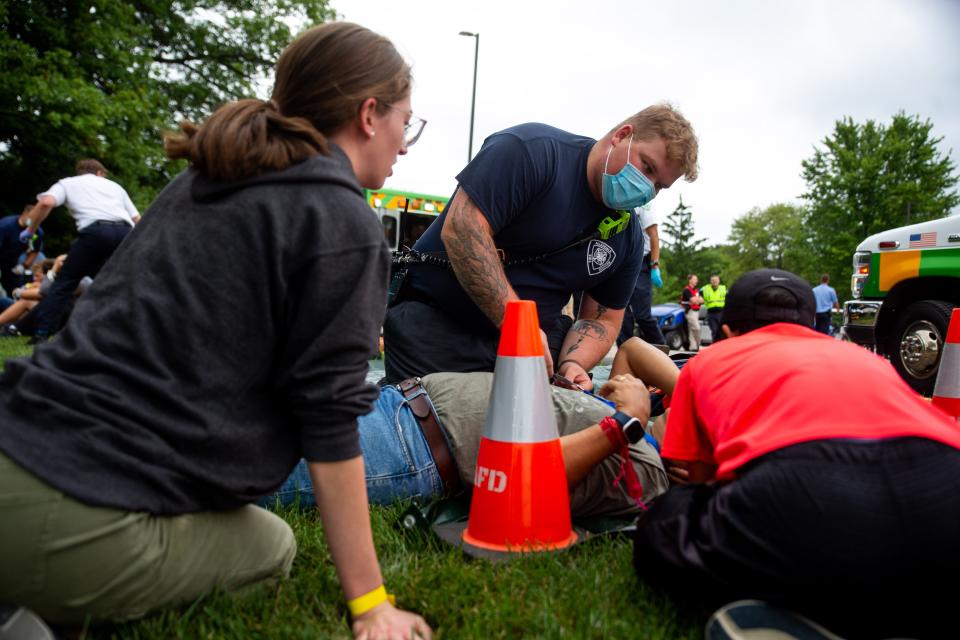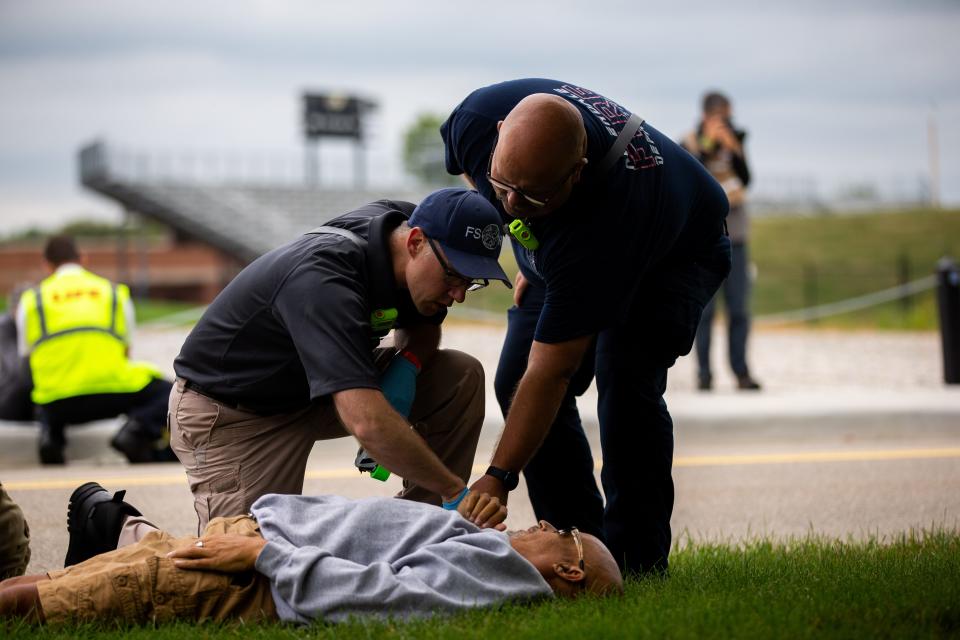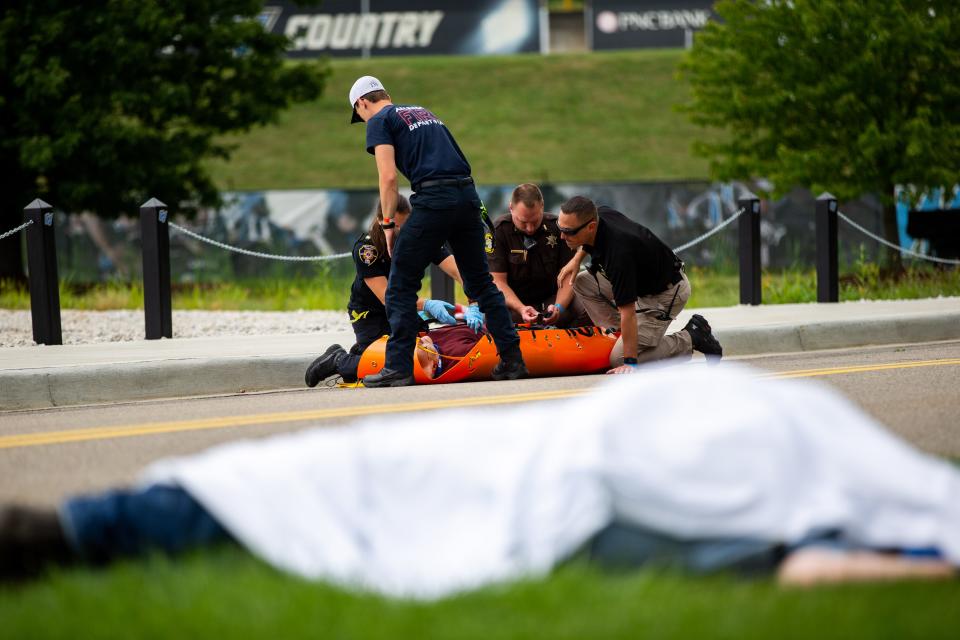Fewer benefits, pay disparities, long hours: Michigan's first responders are spread thin
The concept of pre-hospital emergency medical care hasn't changed much since its inception: a stretcher in a designated vehicle that gets a patient to the nearest hospital.
In 1966, Tom McLaughlin began working in EMS in a small, rural community in mid-Michigan.
“At that time, we were doing simple interventions and getting them to the hospital as quickly as we could,” he said. “That’s different now. It really changed over the years, piece by piece, as the training developed and became standard practice. You might ‘stay and play’ — administer lifesaving interventions in the field and stabilize the patient before transporting.”
Only a few years into his four-decade career, the concept of a paramedic was born when California Gov. Ronald Reagan signed into law the Wedworth-Townsend Paramedic Act in July 1970. Today, the classification system goes first EMT, then paramedic, depending on your level of training and skill.

“It was a relatively new concept and gained traction in the industry,” McLaughlin said.
The training standards and continuing education comprises months of medical training for what equates to sometimes relatively low pay. Paramedic students in Michigan are required to partake in 1,100 hours of training, broken into 500 classroom hours and 600 hours of clinical time.
The grueling hours, low pay, and training requirements aren't appealing to most, especially when jobs in some manufacturing plants pay over $20 an hour, McLaughlin said.
“Call volumes are up and everyone’s shorthanded. ... You might be in that rig for hours at a time running jobs back to back all day long. When I got into it, we were running true emergency calls, really making a difference. Today, people will call for an ambulance for flu symptoms or a lift assist. Are they abusing the system? Some are, for sure. They think they’ll be seen at the emergency room faster if they arrive by ambulance. And that’s not always the case.”
Training for the future
Emergent Health Partners, which operates ambulances in six counties across lower Michigan, announced in March it would seek applicants for its second annual Emergency Medical Technician Academy. There were 18 open positions, all of which are paid — much like an apprenticeship — and compensate recruits for a 40-hour week as they complete the statewide curriculum and licensing process.
Sixteen of those positions were filled by registered applicants, according to Emergent Health Partners' representative Marc Breckenridge.
“(EMS) can be a very rewarding career field,” Breckenridge said. “That's something I like to talk about. Those of us who've been in the field of action, there are times when it's very challenging, and when the outcomes are good, it really feels good to be a part of that.”
Emergent Health Partners, based in Ann Arbor, oversees Albion Community Ambulance in Albion, Huron Valley Ambulance in Ann Arbor, Jackson Community Ambulance in Jackson, Lenawee Community Ambulance in Tecumseh, LifeCare Ambulance in Battle Creek and Monroe Community Ambulance in Monroe.
Upon completion of their coursework, graduates are assigned to work full-time at any of the company's branches, where they're able to receive a full benefits package and paid time off.

“We want to make it easy for them (the trainees), with the stipend and all of the education,” Breckenridge said. “Our instructors are excellent. They all come from the field.”
Students are walking a challenging road. The COVID-19 pandemic and its aftermath, plus a generational shift in the way people seek or desire work, has resulted in a declining number of public safety workers, Breckenridge said.
“It’s a tough line of work. EMS, fire, police and safety are all on the clock 24/7. A lot of people today have expressed the desire to work in a more structured career field with less weekend and evening working hours, as well as less holiday work.”
Offering the academy, he said, was a way to incentivize and encourage people to test out emergency services.
“We just felt that we needed to kick it up a notch,” Breckenridge said. “We knew we needed to do more to get recruits in the door and to be successful.”
'It's a problem everywhere'
Former Madison Township Fire Chief Ryan Rank, of Lenawee County, says public and emergency services are facing a “huge shortage” of employees — not just in Michigan, but nationwide.
“It’s a problem everywhere," he said. "The times have changed. Thirty years ago, when I started in this profession, you would have at least 50 applicants for one open position.”
There's a lot on which the blame can be placed, Rank said — including fewer pensions and benefits, a lack of enticement, pay ranges and disparities, hours required for training, and municipality funding.
“I wish I had a solution for the problem,” Rank said. “There are some incentives out there to draw people into the career, but it comes down to funding and what municipalities can afford to entice people to join.”
With only four full-time positions and averaging about 1,500 calls a year, Jordan Valley EMS Authority Director Meghan Meyers admits putting her employee schedules together each week is like playing a game of Tetris. To cover all shifts, she coordinates with 15 part-timers and 9 volunteers with different needs.
“I’m having to hustle all the time,” she said, pointing to a shift calendar on her wall. “See all those yellow marks? Those are unassigned shifts.”
About four years ago, Meyers started an education program of her own to help attract employees to the Northern Michigan station.
“The fact that we have an education program is our best tool for recruitment,” she said. “I’ve got a class of seven people right now and I’m hoping that four or five of them will join the roster."
The board for the recently started Lake Charlevoix EMS Authority has studied various staffing structures around the state to come up with a workable solution. They run with mostly full-time staffers, including six paramedics and eight EMTs with additional help from six “pager people."

“While we're comfortably staffed now, we would never turn down another paramedic who wanted to come here,” said Authority President Roy Griffits.
Deputy Director Lyon Stephens said one of the biggest problems with recruitment in Northern Michigan is the lack of paramedic education opportunities.
Currently, the state has 28 approved programs for paramedic training, with only three sites in the Upper Peninsula. In the northern Lower Peninsula, there are only two full training sites — one in Emmet County and one in Grand Traverse County, according to Stephens.
Despite the changes and the training and the shortages, Rank referred to his years of service as the “most rewarding time of my life.”
“You're not going to get rich working in EMS, as a paramedic or as a firefighter, but all of my personal rewards are worth much more than any paycheck I was able to bring home."
— Contact reporter Annie Doyle at 231-675-0099 or adoyle@charlevoixcourier.com. Contact reporter Corey Murray at cmurray@hillsdale.net. Contact Brad Heineman at bheineman@lenconnect.com.
This article originally appeared on The Petoskey News-Review: Michigan's first responders are spread thinner than ever

